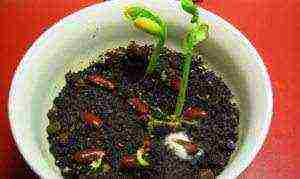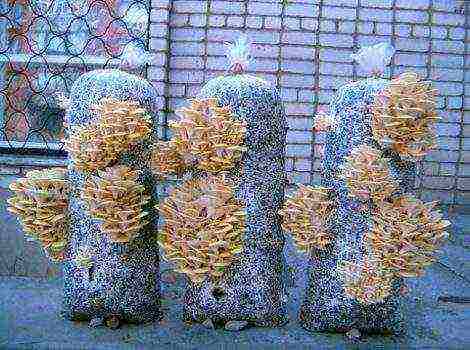Content
- 1 What type to choose for the house
- 2 Soil and capacity
- 3 Comfortable conditions
- 4 Pests and diseases
- 5 Transplant secrets
- 6 Video "Growing an orchid at home"
- 7 Orchid species - descriptions of how to care for orchids
- 8 What types of orchids are grown in our conditions video
- 9 Orchid species photo gallery
- 10 Orchid species suitable for home breeding
- 11 Interesting types of orchids
- 12 Orchid Buying Tips
Phalaenopsis will become a real decoration for your home. Growing orchids at home is carried out according to specific rules, which will be described in detail in this article.
What type to choose for the house
You can grow a variety of orchids at home. However, it is important to choose the right variety so that you do not have problems with flower care in the future. After all, each type of plant has its own set of requirements for growing conditions. If everything is organized correctly, then caring for orchids in a flower pot will be simple.
For growing orchids at home, the following varieties are suitable:
- Phalaenopsis. It is Phalaenopsis that is grown more often at home than other types of plants. This flower is distinguished by long flowering, and its flowers can have a wide variety of colors. Growing any phalaenopsis at home will be within the power of even a beginner;
- Dendrobium. Orchids of this species grow in the cool. The flowering period is more than one month;
- Cattleya. Growing conditions for this variety require a warm, but not hot, microclimate. The formation of rather large flowers is characteristic;
- Wanda. It is a heat-loving plant that has a powerful root system. As they develop, the flowers become brighter;
- Zygopetalum. This variety is characterized by the formation of fragrant inflorescences.
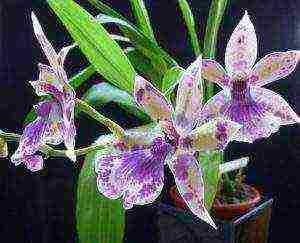
There should be no problems with the orchids listed above at home. However, in order to get them to bloom for a long time, you need to know the types of orchids and the secrets of growing each individual variety.
Soil and capacity
To understand how to grow your favorite orchid in a house or apartment, you need to know the specifics of choosing a container and soil for planting a flower.
Growing plants is carried out in a pot, which must meet the following requirements:
- able to support the flower in an upright position;
- provides oxygen and moisture to the roots;
- promotes effective drying of the substrate.
Plastic pots, wire pots and nets have the right characteristics. The Phalaenopsis orchid and its other varieties are most often planted in pots with transparent walls so that the roots can participate in the process of photosynthesis.
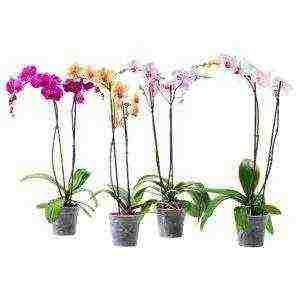
In order to grow orchids at home, you need to choose the right substrate. These indoor flowers are planted on a special substrate, in which there is no earth at all. It may include the following components:
- pine bark;
- peat;
- fern;
- charcoal;
- leafy land;
- pine bark;
- sphagnum.

The ratio of the components of the substrate is determined depending on which plant species is planned to be grown in houses or apartments. The substrate can be prepared by hand. But many growers go to specialized stores to buy soil. In the same place, the seller will tell you how to grow 100 or more specimens from one orchid, having bought only one flower. To do this, you just need to know how a particular orchid is grown.
Comfortable conditions
Home care for Phalaenopsis involves compliance with certain parameters of temperature, humidity and illumination. Let us consider in more detail what kind of care, and what parameters must be observed when growing these flowers. The secrets of growing orchids will be available to you too.
Lighting and temperature
Phalaenopsis loves partial shade. When placing a flowerpot on a windowsill, avoid direct sunlight. Artificial lighting for orchids is allowed. To do this, you can use special phytolamps, which are designed for additional illumination of indoor plants. This indoor orchid lamp is sold in specialized stores.
Additional illumination should give white light. It is this kind of light that is needed in order for the indoor species to grow and bloom. The backlight is often used in winter, when the daylight hours are the shortest. In the cold season, flowers should be illuminated for at least 12 hours. For this, a phytolamp for indoor orchids is placed above the pot.

In addition to the light regime, a certain temperature is needed for orchids. These indoor plants are better tolerated at elevated temperatures. The optimum temperature for keeping colors is in the range of + 28-30 degrees.
For any gardener who has grown Phalaenopsis at home, it will be useful to know that to stimulate flowering, the plant must be at a temperature of + 12-15 degrees for several weeks.
Watering
An important point in how to grow orchids in an apartment is compliance with the water regime. Watering the flower is carried out only when the substrate dries up. Regarding how to correctly determine the degree of dryness of the substrate, there are several ways (poke into the ground with your finger or stick, etc.). You need to water the plant only with settled warm water.

Humidity
These plants should grow in a humidity range of 60–80%. In order to achieve this level, the plant is periodically sprayed with water and also ventilated. Ventilation is essential for cold tolerant species.
How to care for a particular species, you can find out from the seller, who will tell you all the wisdom of its breeding. Experienced growers can also give advice on breeding.
Pests and diseases
For many flower lovers who grew in the conditions of the Phalaenopsis apartment, the flowers were often invaded by parasites or pathogens. Such a situation is possible if planting and care were improperly organized for them (plants).
Plants most often suffer from the following parasites:
- shield. When it appears on the plant, mucus and dark spots are formed;
- worm. When infected, the leaves turn yellow, which then fall off;
- whitefly. The insect feeds on plant sap. As a result, the flower may die.

These indoor flowers most often affect the following ailments:
- anthracnose. The appearance of brown spots is characteristic;
- powdery mildew. A white bloom forms on the flower.
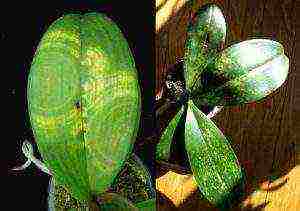
How to grow Phalaenopsis without diseases and pests? You just need to properly organize the care for the plant. This is easy to do, because you only need to create the correct water and temperature conditions, as well as lighting.
Transplant secrets
An orchid in its cultivation includes a mandatory transplant, which is carried out every two years. More frequent transplants are carried out only when necessary (for example, a large number of parasites in a pot).
The transplant should be done in the spring or summer.This procedure consists of the following steps:
- the plant is well watered in a day;
- then the flower is taken out of the pot and placed in water to soak off the roots of the substrate;
- further all rotten roots are removed;
- the plant is placed in a selected pot and covered with new soil;
- watering is carried out after 1-2 days.
The secret of a successful flower transplant lies in the fulfillment of these points.
Now you know the secrets of growing and caring for indoor orchids.
Video "Growing an orchid at home"
This video will show you how to grow a blooming orchid at home.
Orchid (Orchids and Orchids) is a plant of the flowering department, monocotyledonous class, of the order of asparagus, of the orchid family (Latin Orchidaceae). Orchids are one of the richest species of plant families.
The orchid plant got its name in ancient Greece thanks to the philosopher Theophrastus, a student of Plato. As a result of scientific research, the scientist came across an unfamiliar flower with roots in the form of a paired bulb and gave it the name "orchis", which means "egg" in Greek.
back to content ↑ Orchid flower: description, characteristics and photos.
Orchid flowers make up one of the most numerous plant families, the main part of which in nature is perennial grasses. Shrub form and woody lianas are less common. Orchids can vary in size from a few centimeters, although individual species grow up to 35 meters in height.
Most of the orchids are epiphytes that grow on other plants, using them as a support and are not parasites at the same time. Epiphytic orchid flowers do not depend on the soil, receive more light and suffer less from herbivores.
Orchid epiphyte
The roots of the epiphyte orchid are extremely important organs as they perform many essential functions. First, with their help, orchids are attached to the substrate, which allows them to maintain an upright position. Second, the roots are actively involved in photosynthesis, sharing this function with the leaves. Thirdly, with the help of the root system, orchid flowers absorb moisture and nutrients from the air and bark of the plants on which they live.
Another, smaller part of orchids are lithophytes growing on rocky and stony rocks. Terrestrial orchids make up the medium-sized group. Both types are endowed with underground rhizomes or tubers.
Orchids lithophytes
The green stem of an orchid can be long or short, creeping or erect. Leaves are simple, alternate, on each plant there may be one or more of them.
Orchid flowers of the most varied colors and sizes form 2 types of inflorescences: a simple ear with a single arrangement of flowers or a simple brush with several flowers on pedicels growing along the stem.
The orchid flower belongs to insect pollinated plants, and the mechanisms of pollination of each species are sometimes unusual and very diverse. Shoe orchids, which have a "shoe-like" flower structure, are endowed with a special trap for pollinating insects.
Orchis have sticky legs, the flowers of this orchid mimic the smell of female bees, thereby attracting males.
Flowers of tropical orchids stupefy insects with an unusual aroma, other species shoot pollen towards the pollinator insect.
Orchis
The orchid fruit is a dry capsule containing up to 4 million microscopic seeds, which is a kind of productivity record among flowering plants.
Orchid fruit
The life span of orchids in natural conditions is individual, depends on many factors and under favorable conditions can be 100 years. In greenhouse conditions, many types of orchids live up to 70 years.
back to content ↑ Orchid species - names, descriptions and photos.
The modern classification of orchids, developed by the American scientist Dressler, contains 5 subfamilies, each of which is subdivided into several genera and many species:
- apostasy (Latin Apostasioideae) is a primitive subfamily consisting of 2 genera: neuvidia (Latin Neuwiedia) and apostasy (Latin Apostasia) and 16 orchid species, which are small herbaceous perennials. These orchids grow in Australia, New Guinea, Indochina and Japan.
Orchid of the genus Apostasia (Apostasia)
Orchid of the genus Neuwiedia
- cypripedia (Latin Cypripedioideae) - represent 5 genera and 130 species of orchids, consisting of terrestrial, rocky and epiphytic perennial grasses. One of the well-known genera is the Lady's Slipper, 5 varieties of which are found in Russia. The range of the subfamily is distributed over the temperate, tropical and subtropical latitudes of all continents, except Africa.
Lady's slipper (Cypripedium calceolus)
- vanilla (Latin Vanilloideae) - the subfamily includes 15 genera containing 180 species of orchids. Herbaceous plants or vines are distinguished by a large number of flowers in the inflorescence. The fruits of representatives of the genus Vanilla (Latin Vanilla planifolia) contain vanillin, which is widely used as a spice, perfumery and pharmacology. These orchids grow in the tropics of the African continent, Central, South America and Asian countries.
Orchid subfamily vanilla (Latin Vanilloideae)
- epidendric (lat. Epidendroideae) - the largest subfamily consists of more than 500 genera, forming over 20 thousand species of orchids. They are epiphytic perennials, less often terrestrial grasses, extremely rarely vines. Dactylostalix (Latin Dactylostalix), listed in the Red Book of Russia, is considered a remarkable genus. And also the genus Cattleya (lat. Cattleya), distinguished by fragrant, large, exceptionally beautiful inflorescences. These orchids grow in the temperate, tropical and subtropical zones of all continents.
Dactylostalix (lat.Dactylostalix ringens)
Cattleya Orchid
- orchids (orchids) (Latin Orchidoideae) - the subfamily unites 208 genera and almost 4 thousand species of perennial terrestrial plants with an erect stem. The genus of orchids Anacamptis (Latin Anacamptis) with beautiful spike-shaped inflorescences of bright color is considered interesting. And also representatives of the genus Palchatokorennik or Dactyloriza (Latin Dactylorhiza), the dried roots of which are used in case of poisoning and as a nutritional component in depletion. These orchids are found on all continents except Antarctica. The genus Phalaenopsis is also very common; it is the representatives of this genus that are widely cultivated at home.
Anacamptis pyramidal (lat.Anacamptis pyramidalis)
Anacampis (lat.Anacamptis papilionacea subsp. Grandiflora)
May fingernail (lat.Dactylorhiza majalis)
Fingering (orchis) fuchs (lat.Dactylorhiza fuchsii)
back to contents ↑ Phalaenopsis orchid.
Shades of Phalaenopsis orchids can be classified as follows:
- black Orchid;
- blue orchid;
- blue orchid;
- yellow orchid;
- red orchid;
- purple orchid;
- White orchid;
- pink orchid.
Phalaenopsis Orchid
back to content ↑ Orchid varieties - names, descriptions and photos.
There are endless varieties and varieties of orchids, among which the following can be distinguished:
Cattleya labiata (lat.Cattleya labiata). One of the largest representatives of cultivated orchids, although there are also small cattleyas. This variety has a very beautiful flower with wax-coated petals and a corrugated lip. The color of the orchid flower, which “lives” for almost three weeks, is the most versatile - from pale pink and beige tones to deep purple.
Cymbidium Orchid (lat.Cymbidium). An excellent variety of orchids, resistant to stress and unpretentious to care for. Hanging stalks contain 10-13 orchid flowers of the most unimaginable palette - from boiling white to purple or bright orange. This orchid variety blooms profusely and continuously for 8-10 weeks.
Fragrant lycast "Gold" (lat.Lycaste aromatica). This orchid variety is loved by connoisseurs for its spectacular bright lemon-toned flowers with a delicate and persistent aroma. Peduncles are high, up to 25 cm, flowers in diameter often exceed 15-17 cm.
Darwinar's Orchid (lat.Darwinara). A miniature hybrid of an orchid with very dark, leathery leaves and a graceful inflorescence, including small, 2-3 cm in diameter, blue-violet flowers. The inflorescence is racemose, may contain 7-12 flowers with a delicate aroma.
Potinara «Burana Beauty» (lat... Potinara Burana Beauty, Rhyncattleanthe). The hybrid is distinguished by luxurious variegated yellow-red flowers, with wavy petals. The peduncle of an orchid of medium height, this orchid variety blooms all summer, and with proper care it pleases with beauty even in the first autumn month.
Cymbidium "Twelve" (lat... Cymbidium Twelve). An orchid with long, rather narrow leaves. The cymbidium "Twelve" orchid bud is whitish-pink in color, with a slight reddish speck. Inflorescences drooping, racemose, short.
Orchid Dendrobium Nobile (Latin Dendrobium nobile) sometimes reaches 60 centimeters in height, the minimum growth of this individual is about 30 centimeters. The diameter of one bloom varies from 4 to 7 centimeters. And the branch of the Dendrobium Nobile orchid can have inflorescences of different tones.
back to contents ↑ Where do orchids grow?
Representatives of the largest family of orchids adapt so easily to habitat conditions that they have spread almost all over the globe and feel comfortable in absolutely all climatic zones, except for the harsh Antarctica. The main part of orchid species grows in the tropics, but these luxuriously flowering plants can be found in latitudes with a temperate climate. Europe and Asia, the countries of North and South America - anywhere orchids perfectly adapt to natural conditions, bloom profusely and increase their range.
back to contents ↑ Planting orchids at home.
Surprisingly, contrary to popular belief that an indoor flower should grow in a pot with soil, orchids prefer to "dwell" in containers with a substrate of bark, sand, forest moss, peat and even foam. Orchid soil can be bought ready-made, or you can make it yourself.
Pine bark is usually taken from a “dead” tree. It is crushed, boiled in water and dried. For moss, only the upper green part is used, after washing it with boiling water and grinding it. The sand for the substrate is only coarse. You can also add charcoal, foam chips and small expanded clay to the mixture. The components are mixed and thoroughly moistened immediately before planting the orchid.
Bulbophyllum frostii (Latin Bulbophyllum frostii)
By the way, when choosing a pot for an orchid, stop at pots made of white or other light plastic: they will bask less in the sun. Wicker baskets or pots are perfect for planting orchids. You need to plant the plant as carefully as possible so as not to damage the rather fragile roots of the orchid. You should not tamp the substrate - just fill them in the voids around the rhizome of the flower.
back to content ↑ Orchid care at home. How to care for a potted home orchid?
Lighting for orchids.
Proper lighting is a major factor in the care of your home orchid. The plant needs 12-15 hour daylight hours, so additional lighting will be required on short winter days. In other seasons, it is better to place the plant on the east or west side of the room, closer to the window. The south windows will have to be shaded; on the north side, you will need constant fluorescent lighting.
Flying Duck Orchid (lat. Caleana major)
back to contents ↑ Orchid: temperature control.
The temperature regime for an orchid depends on the type of plant. Phalaenopsis and other tropical orchid species are kept in summer at temperatures up to +32 degrees, during winter night hours the temperature should not fall below +15.
Dendrobiums, miltonia and other species native to the subtropics prefer a more gentle atmosphere: +22 in summer daytime hours and + 12-15 degrees in winter.
The indoor orchid grows well and blooms at an air humidity of 60-70%. Spraying has a short-term effect and, unfortunately, contributes to the development of infections and leaf rot. Therefore, the best option would be to use air humidifiers, install open containers of water and moisten the gravel in the pan. Spraying the orchid should be minimized, being careful not to get water on the flowers.
back to contents ↑ Watering orchids. How to water an orchid?
"How to water an orchid correctly?" - a question that worries many lovers of this beautiful plant. Orchids cannot tolerate stagnant water, which can lead to yellow leaves and root rot. For watering orchids, it is better to use soft water - rain, thawed or boiled. Summer watering of an orchid is carried out after the soil or substrate dries up, 2-3 times a week, in winter it is rarely watered, as soon as the pseudobulb begins to wrinkle.
back to contents ↑ Orchid transplant. How to transplant an orchid?
Many people ask the question: "How to transplant an orchid?" Orchids are transplanted only if necessary, this process is often replaced by transshipment into a larger container. The best "dwellings" for an orchid are ceramic or plastic pots with holes in the walls or a basket.
Brick fragments or granite crushed stone are used as drainage, which is filled with 1/4 of the container. Holes and slots are laid with sphagnum. The substrate is prepared from 5 parts of pine or willow bark, 2 parts of sphagnum and 1 part of charcoal. If you add crushed fern rhizomes, fallen leaves of trees and peat to the mixture, you can do without top dressing. The orchid is carefully lowered into the container, the fragile roots are straightened and the voids are filled without compacting the substrate. Then the plant is fixed with wire and is not watered for 5 days.
Radiation guide (lat.Pecteilis radiata)
With a timely (once every 2-3 years) transplant, orchids can do without feeding at all, getting the necessary nutrition from the substrate. An excess of fertilizer suppresses the plant's immunity, which reduces orchid flowering and leads to infections. A high concentration of mineral salts can lead to the death of the plant, and if there is a need to feed the orchid, it is better to use special fertilizers: Bona Forte, Kristalon, Pokon, Compo or Greenworld. When using any fertilizer for orchids, the recommended dose should be halved. Orchid feeding is carried out only in spring and summer, during the period of plant growth.
To stimulate flowering, it is advisable to treat orchids with the preparations "Ovary", "Bud", "Blossom".
Oncidium warty (Latin Oncidium varicosum)
Phalaenopsis rosea
back to contents ↑ Reproduction of orchids.
Representatives of various species and even genera are able to interbreed and produce numerous hybrids. Targeted interspecific pollination has given birth to hundreds of thousands of artificial orchid hybrids, many of which have become favorite houseplants. Representatives of the genera Phalaenopsis, Cattleya and Dendrobium are especially popular. Each type of orchid has individual recommendation nuances for keeping conditions and rules for care and breeding common to all types.
Orchids are propagated in any of 3 known ways:
- lateral stem shoots - children, which are separated from the mother plant and planted separately;
- by layering - air suckers, by rooting on the mother plant in a special greenhouse and with subsequent separation;
- vegetatively, dividing the rhizome and planting fragments containing 2-3 pseudobulbs.
back to contents ↑ Orchid bloom.
An orchid plant, subject to proper lighting and proper care, can bloom 2 times a year, in spring and autumn. Non-infectious diseases in a plant occur due to hypothermia, excessive watering, insufficient lighting, and sunburn.Long-term negative impact is fraught with the death of the plant.
Golden orchid
Black Orchid
back to contents ↑ Diseases of orchids.
Orchid diseases are rare and require specialist intervention:
- Bacterial leaf spot. The disease is fairly easy to treat. Isolate the "patient" from other indoor flowers! Remove damaged parts of the orchid by cutting off with scissors. Treat the slices with ordinary brilliant green, cinnamon powder or activated carbon.
- Anthracnose. With this disease, be sure to eliminate all diseased parts on the plant! Spray the orchid with Sandofan, Previkur, or Profit fungicides.
- Powdery mildew. If there are visible signs of this disease, pour abundantly the container in which the orchid is growing with water several times. After a couple of hours, spray the plant with a solution of colloidal sulfur or Topsin-M.
- Rust. The disease is serious but treatable. The orchid plant should be thoroughly rinsed under running water, without fear of flooding it, replace the substrate in the container. Then it is necessary to sprinkle the orchid with a slightly pink solution of potassium permanganate and treat it with the Manual-Orchid agent from a spray bottle.
- Root, black, gray, fusarium rot. It is imperative to remove the affected areas on the plant by cutting off with scissors and sprinkling with crushed activated carbon. Replace the substrate with a new one, before washing the container and orchid roots in a pink solution of potassium permanganate.
- Sooty mushrooms. Flower disease can be cured by spilling the substrate twice and spraying the plant with preparations such as "Mikosan" or "Topsin-M".
Below are the answers to the most frequently asked questions for orchid flower lovers.
back to contents ↑ Why doesn't the orchid bloom?
In any case, this beauty refuses to bloom because of the poor conditions of its detention. The absence of flowers can be caused by excessively dry or very humid air, the temperature of the flower content below 22-25 degrees, lack of sunlight, or, on the contrary, too "hot and sunny" windowsill.
Phalaenopsis orchid flower
back to contents ↑ Why does the orchid turn yellow?
This can happen in different ways. Due to excess fertilizers or excessive organic feeding, due to excess or lack of light, due to damage to the plant by pests, mechanical damage to the roots, dry indoor air and flooded soil in the container.
back to contents ↑ Why isn't the orchid growing?
Make sure the growing conditions are right! Perhaps you just flooded a pot with a plant, or you put a container with an orchid on a window that is too sunny. Another reason is a very small container in which a flower grows, and an illiterately composed substrate: the roots of an orchid need space and a lot of air. The heavy soil does not suit this beauty at all!
Orchids of the genus Dracula (Dracula simia)
back to contents ↑ Why does the orchid fall?
There are many reasons for the dropping of buds or flowers of an orchid. Lack of light, draft, heat or cold, dry air in the room, stress as a result of "moving" the plant to another place, incorrect watering regime. In all these cases, the orchid gets sick and sheds its luxurious flowers, and sometimes leaves.
Anguloa uniflora (Anguloa uniflora)
back to contents ↑ How to save an orchid?
Many people ask this question. To do this, do not overheat the orchid and burns under the scorching rays of the sun, do not place a container with an orchid in winter next to heating devices that dry out the air, do not moisten the soil in the pot unnecessarily, do not "chill" the heat-loving beauty while airing the room in a cold season.
back to content ↑ Orchid: beneficial properties. The use of orchids.
In addition to exceptional decorative properties, some types of orchids have valuable beneficial properties that are widely used in folk and traditional medicine.
Tubers of certain orchid species contain a large amount of mucus, rich in antiseptics and immunoglobulins, as well as starch and protein. A decoction of the roots of Lyubka two-leaved (lat. Platanthera bifolia) is used for indigestion, inflammation of the bladder, as an analgesic and antiseptic.
Two-leaved Lyubka (Latin Platanthera bifolia)
The roots of the Cremastra orchid (Latin Cremastra appendiculata) are used as a pain reliever and antidote for snake bites. Dendrobium nobile or noble (lat. Dendrobium nobile) is used for diseases of the gastrointestinal tract, pain syndromes and as an aphrodisiac. Three-fold or triple calantha (lat.Calanthe triplicata) is used to treat diarrhea, relieve swelling and all kinds of pain. Anectochilus royal (Latin Anoectochilus regalis) is a rare epiphytic orchid, from which valuable medicinal oils are obtained.
Ophris bee
Bee ophrys (lat.Ophrys apifera)
back to contents ↑ Orchid: interesting facts:
- The orchid flower is rightfully considered one of the most extraordinary plants, there are many beautiful legends about it. Confucius called the orchid “The King of Fragrant Flowers”.
- In the 19th century England was gripped by "orchid fever": growing orchids was considered a sign of good form, and real collectors were not intimidated by the price of 500 pounds for a new plant.
- The amazing beauty of the orchid fascinated Charles Darwin and inspired the scientist to create a fundamental two-volume work on orchids, which is still considered the best in the field.
- Orchids last longer than other flowers in cut, although in many countries it is not customary to give orchids.
- At the end of the 19th century, the largest orchid flower was discovered in the Malay archipelago, its petals reached a length of 90 cm.
- According to psychologists, contemplation of a blooming orchid can cure depression. In addition, the orchid does not cause allergies - a rare quality for flowering plants.
Orchid Dracula robledorum
Orchid Ophrys Vernixia
Orchid inseciferous orchid (Ophrys insectifera)
Did you like the article? Share with your friends:
Probably, there is no person on earth who, at least once in his life, would not admire the magnificence of orchids. Everyone admires these flowers: from housewives to florists. However, for a long time, true connoisseurs of beauty could observe the flowering of this plant only at a distance, but not so long ago, hybridizers managed to breed varieties and types of orchids that can be grown at home, moreover, without much effort and time. (See also Rose varieties with photos and names).
Content:
- Orchid species - descriptions, useful information
- What types of orchids to grow - expert advice
- Orchid species photo gallery
Recently, the orchid has actively begun to displace the queen of flowers, the rose, from the leadership position. And it is not surprising that more and more orchids in pots began to be given for all kinds of holidays.

True, many happy owners of such a flower first of all get lost and do not know how to save its life, how to care so as not to injure the beautiful petals, how to transplant it correctly.
For such cases, there are special types of orchids that will easily take root on your windowsills.

There are two types of indoor orchids:
- Sympodials are regularly updated. When one bud fades, several new buds appear instead of it. In addition, this species shoots from the sides at the base of the flower, due to which the orchids bloom in several branches at once. Sympodial plants have pseudobulbs - stem tubers that accumulate nutrients necessary for the plant. Among the sympodial species are Cattleya, Cymbidium and Dendrobium.
- Monopidial orchids have only one straight stem from which all leaves grow and live as long as the stem itself. Buds for the buds appear in the axils of the leaves.Vanda-type varieties grow very large and bushy. But most often on the windowsills you can find Phalaenopsis, these are rosette-shaped plants, their stems reach 10 cm in height.
Orchid species - descriptions of how to care for orchids
Phalaenopsis
Phalaenopsis is a variety that includes about 70 more sub-varieties. Their homeland is Australia and Indonesia, so the tropical climate is the most acceptable for them. The flowers received such an unusual name due to their similarity with the shape of butterflies.
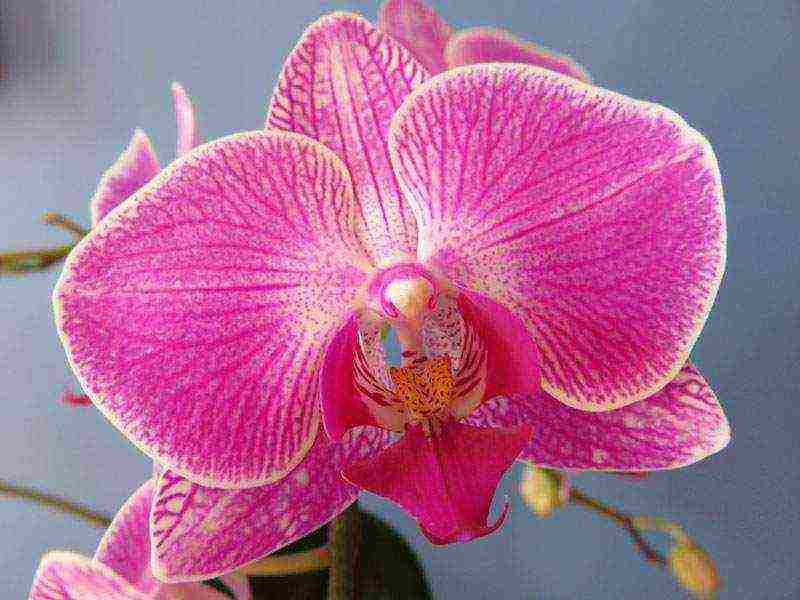
In addition to the intricate name, there are also folk ones: butterfly orchid or Malay flowers. It is the beauty of the inflorescences that attracts flower lovers so much, moreover, phalaenopsis are quite easy to care for.
This type of orchid belongs to the class of monopodial, since it consists of a straight stem, from which short shoots are formed and inflorescences are collected, and the leaves grow from the base of the plant.
Most subspecies have broad, deep green leaves, however, some subspecies have stunning marble-like leaf patterns. Up to 15 large and very beautiful butterfly flowers grow on arched peduncles of this species.
In order for the next time the orchid to bloom with renewed vigor, as it fades, it is necessary to cut the flowering shoot 3-4 cm from the base. With proper care, it will bloom two to three times a year. The flowering processes are influenced only by the owner's care, whether it is sunny outside the window or cloudy - it does not matter.
Phalaenopsis has a wide range of colors, the most popular are white, light pink, hot pink, orange and yellow orchids. Lilac and light green flowers are not so common.
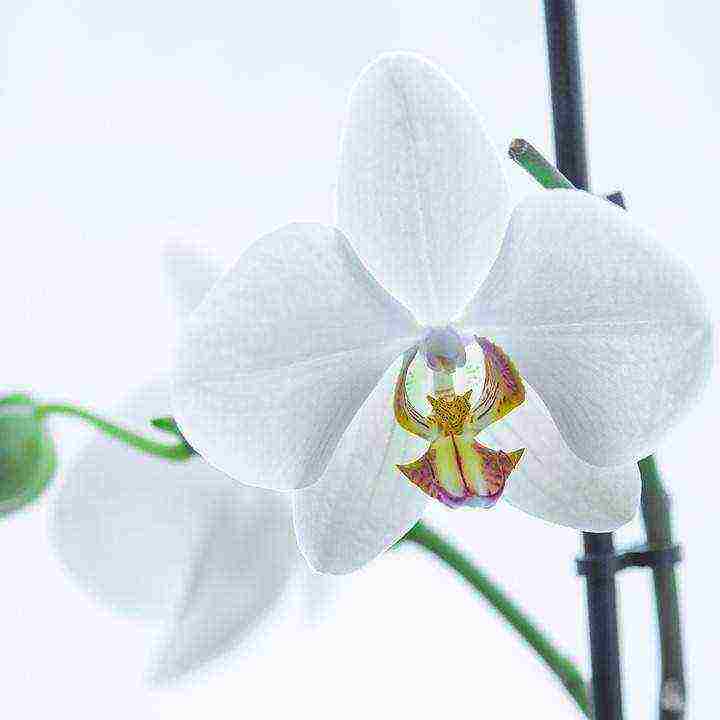
In order not to ruin the plant, it must be protected from bright sunlight. It will be best if they stand on the windowsills of the windows on the west or east side.
It is important to create conditions that are as similar as possible to a tropical climate, so the room temperature should not drop below 12 degrees and rise above 25.
It is extremely rare to moisten the soil; it must be dry. However, it must be completely moistened, it is good if it is possible to put the substrate in water for a while, and then let it drain.
They can be transplanted a maximum of once every two years. Since this procedure is very difficult for them. From March to September, it is necessary to fertilize the plant with a special solution, which can be purchased at florist shops.
Orchid species - Cattleya
Cattleya grows in South America and has more than fifty subspecies.

Cattleya is divided into two types:
- Purple and white, with a wonderful aroma, orchid growing from the top of the pseudobulb. The bulbs themselves release one leaf at a time.
- Orchids in a wide range of colors, with corrugated edges. Pseudobulbs have a cylindrical shape, several leaves grow from them at once. The flowers are very dense in texture, have a great aroma, bloom for 2-4 weeks, cut flowers retain their original appearance for up to 25 days.
Cattleya bloom from April to September, the rest of the time the orchid grows without buds. It is desirable that during the rest period, the room temperature does not exceed 18 degrees during the daytime and 10 at night.
Cattleya requires a lot of heat and sun and it is better to choose south-facing windows. But active sunlight is just as harmful to this variety as it is to phalaenopsis, so at noon, it is necessary to limit flowers in sunbathing. In winter, one cannot do without illumination of fluorescent lamps.
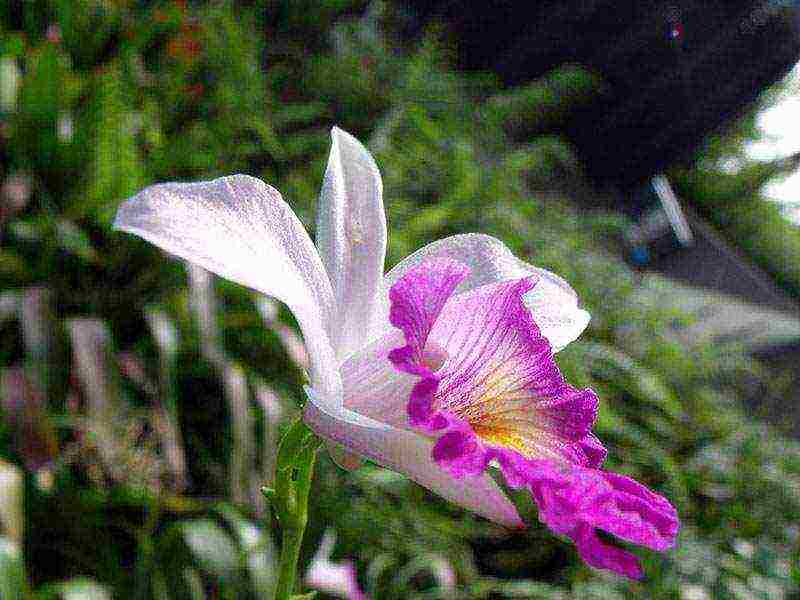 Orchid species - Cattleya
Orchid species - Cattleya
During the period of active flowering, the plant needs regular watering. During hibernation, the regularity should not be disturbed, however, Cattleya requires much less water.
In addition, from April to September, it is imperative to fertilize the orchid with complex solutions. For this type, a transplant is necessary. Every two years, the bulb families should be divided so that you get 3-4 pieces in one pot.
Orchid species - Bulbophyllum
The largest orchid variety in terms of its number is Bulbophyllum, its family includes about 2000 subspecies, which can be found almost throughout the entire tropical zone.
Ideal conditions for home planting are a slatted basket and special soil, which includes sand, bark and sphagnum.
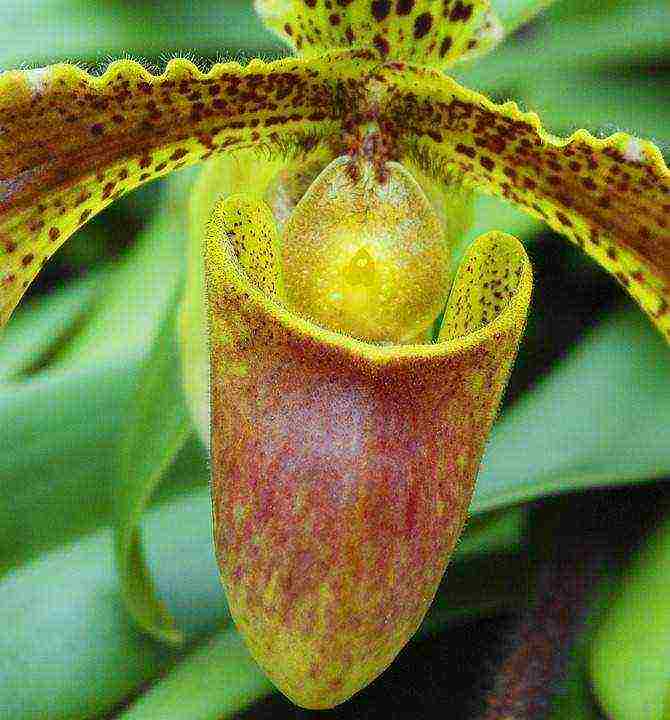
Bulbophyllum blooms in small buds in two rows along the shoot, the smell of flowers is very pungent. Different subspecies have leaves of different shapes. Some subspecies of this family bloom only in winter, others - in summer, for example, "lobby".
They should be treated with special solutions twice a month. Transplanting this species is also undesirable. Dividing a bush is one of the ways a plant propagates. Bulbophillums reproduce on their own using bulbs.
Wanda
In New Guinea, Indonesia or the Philippines, you can find these beautiful flowers. Their natural habitat is rocks and tree crowns.
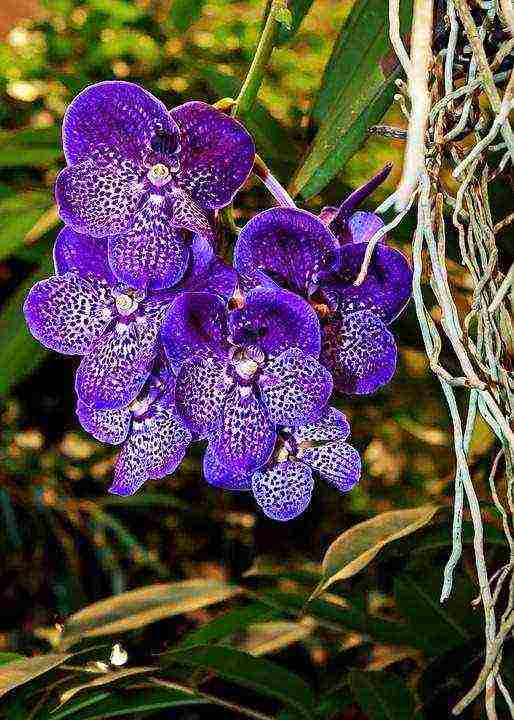
This type of orchid is one of the largest in size, Wanda shoots reach 1.5 in height. However, if there is no way to observe the growth of flowers in their homeland, then there is an opportunity to have flowers at home. Moreover, in indoor conditions, the height of the plant does not exceed 80 cm.
Orchid leaves grow in two rows around a dense stem. In the axils of the leaves, flowering shoots are formed, on which there are usually several inflorescences at once.
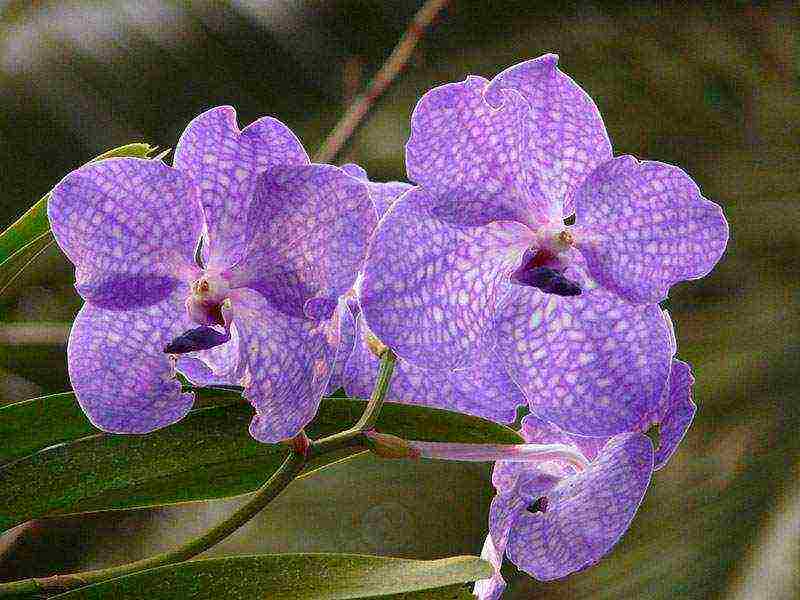 Orchid Wanda
Orchid Wanda
In one inflorescence there are many rather large flat flowers with a sharp aroma, together forming a brush. Orchids of this type are solid, however, this color is very bright. The most common shades of Wanda are white, blue, purple and pink.
Vanda blooms from two to three weeks in the warm season. Cut branches can stand in water for up to 10 days. In order for the variety to bloom, it is necessary to create conditions for it with good lighting and low humidity.
Since Wanda is very fond of warmth, the temperature in the winter in the room should not drop below 15 degrees, otherwise the plant will die.

Regardless of whether the orchid is blooming during this period or not, the soil should be kept moist all the time. Roots that are not covered with soil should be additionally sprayed with water.
Dracula Orchid
Despite the fact that there are up to 120 species in the family, this type of orchid is quite rare. Dracula grows on tree trunks in Mexico, Ecuador and Colombia.
The maximum height for a plant is 3 meters. The name of the flower is no coincidence. Firstly, the buds are strikingly similar to the mouth of a dragon, and secondly, in addition to insects, bats also pollinate the flower.
And, finally, thirdly, it is easiest to recognize Dracula among other orchids by its color - black. Its shades are unique to the entire floral world.
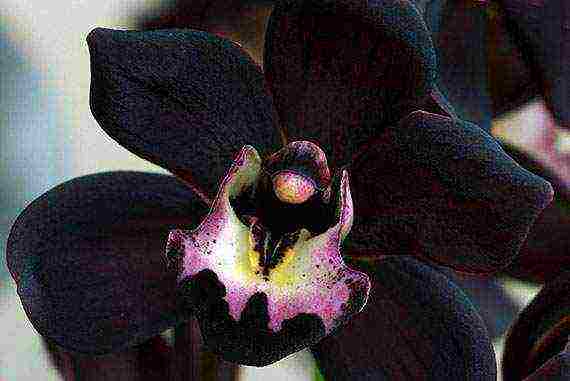 Dracula Orchid
Dracula Orchid
Like the bats themselves, Dracula requires a darkened room with moderate temperatures and very high humidity, at least 70%. If possible, take the plant outdoors in summer.
Orchid species - Dendrobium
Quite a large family - Dendrobium. About 1600 species of this variety grow in the forests of Australia and South Asia. The variety got its name due to the fact that it grows on trees.
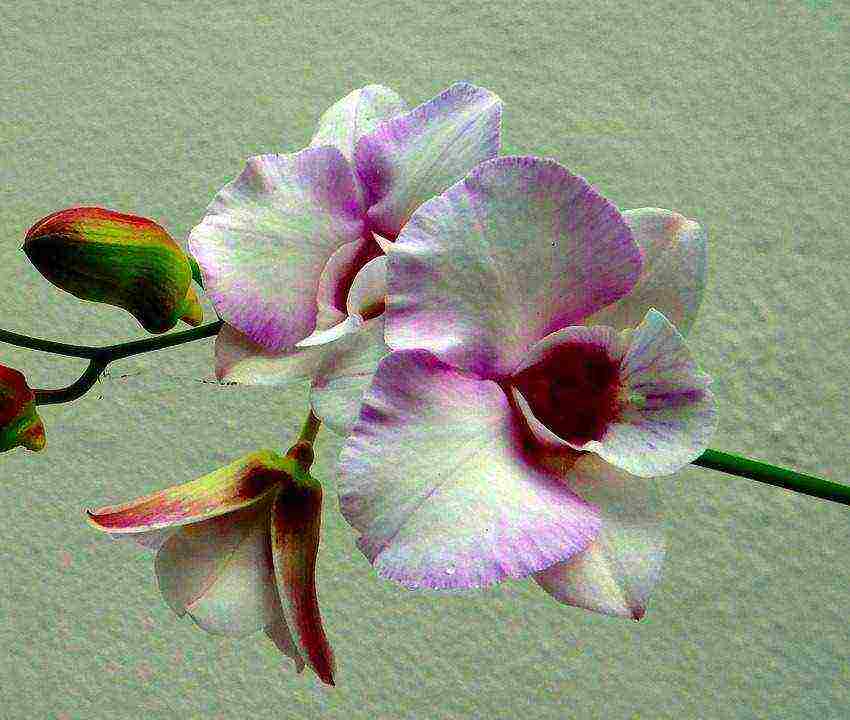
Dendrobium translates as "the one that lives on the tree." Outwardly, the subspecies of this family differ:
- orchids with hanging long bulbs;
- orchids with short fleshy bulbs;
- orchids with elongated vertical bulbs.
Dendrobium belongs to the group of sympodial orchids. The sizes of plants, stems and leaves are different for all subgroups. The inflorescences form a cluster of 15 buds.
Orchids of this family are more common in yellow color. However, in nature there are still white, red and light green Dendrobiums. Unfortunately, not all species have a pleasant aroma.
Dendrobium blooms in late winter - early summer. At this time, flowers and litsya need increased moisture.Transplanting, like other species, is very rare, only if it is necessary to change the soil.

The types of orchids listed above can take root quite easily and quickly at home, however, in order for them to please you with their flowering, you need to make a little effort, because these plants are exotic, not accustomed to the conditions of our latitudes.
Caring for orchids is not so difficult, but the result of your care will result in an abundant and unique flowering.
What types of orchids are grown in our conditions video
Orchid species photo gallery
All flowers are beautiful in their own way, but there is a flower that can bewitch with its magnificent, truly royal appearance. We are talking about orchid.
Have you ever been to greenhouses or landscape design centers? How can you tear yourself away from the rows where the orchids are displayed?
How can you refrain from buying your favorite copy, despite the huge variety of other equally beautiful flowers? It is, indeed, a magical plant, with which many legends and myths are associated. And how not to get confused among the species diversity of orchids and choose the one that you can grow on your own at home?
In this article, we want to help you a little and talk about the most popular and adapted to our window sills types of orchids.
You can find a detailed description of this crop and agricultural techniques for growing it in an apartment in our previous article. We advise you to read it before proceeding with the selection of the right orchid variety for you.
Orchid species suitable for home breeding
1. Cattleya
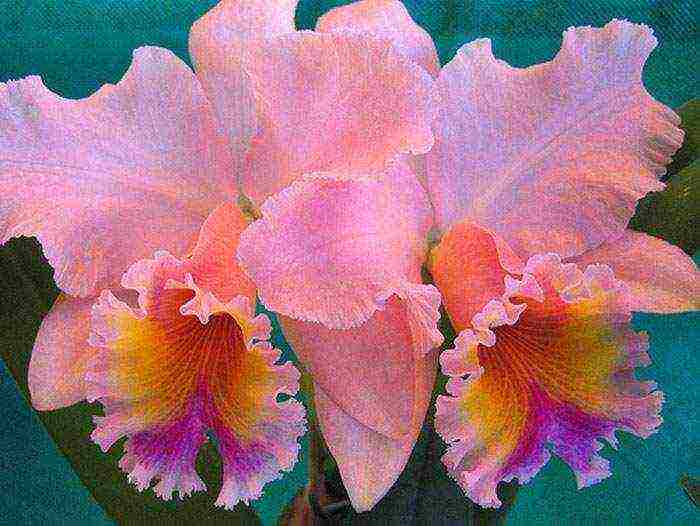
In room culture, this is one of the flowering orchids most beloved by flower growers. This plant owes its name to the English gardener William Cattley. The natural habitat of this species is the American tropics and subtropics (Brazil, the Amazon jungle). The first Europeans, who saw the flowers of Cattleya, considered it so divine that they assigned its varieties the names of Christian saints and significant dates.
Cattleya distinguished by its unusually colorfully painted lip. In addition, its flowers can take on a wide variety of colors - purple, pink, crimson, yellow ...
This type of plant has such interesting intergeneric hybrids as Leliokattleya, Brassokattleya, Sofroleliokattleya.
Cattleya in home culture
These orchids need warm or moderately warm maintenance (from +15 to +30 degrees). The flowering periods are also different. But all orchids of this species need to be provided with moderate humidity, bright lighting, good ventilation, and effective drainage. Watering should be carried out with warm (+ 30- + 35 degrees) softened water, but only after the substrate is completely dry. Fertilization is recommended in moderation once every three weeks during the growth period.
Advice
This kind is often used in floristry for drawing up flower arrangements - its flowers are able to maintain their freshness for up to 6 weeks. In the summer, if you choose for your orchid a dark, windless, protected from rain, place in the garden or on the balcony, then please not only yourself and your loved ones to contemplate a magnificent flower, but also the orchid itself - with conditions close to its natural growth.
2. Cymbidium

If scandals often occur at your home, and your household is not able to contain their irritability, then get yourself Cymbidium orchid... It is ideal for windowsill breeding.
The orchid will gladly accept your care and will thank you not only with delicate, pastel colors, small flowers (up to 4 mm in diameter), but will also fill your home with warmth, peace and understanding.
This orchid blooms in winter, and in length it can grow up to 70 cm. The period of its flowering is quite long - several months.
3. Dendrobium
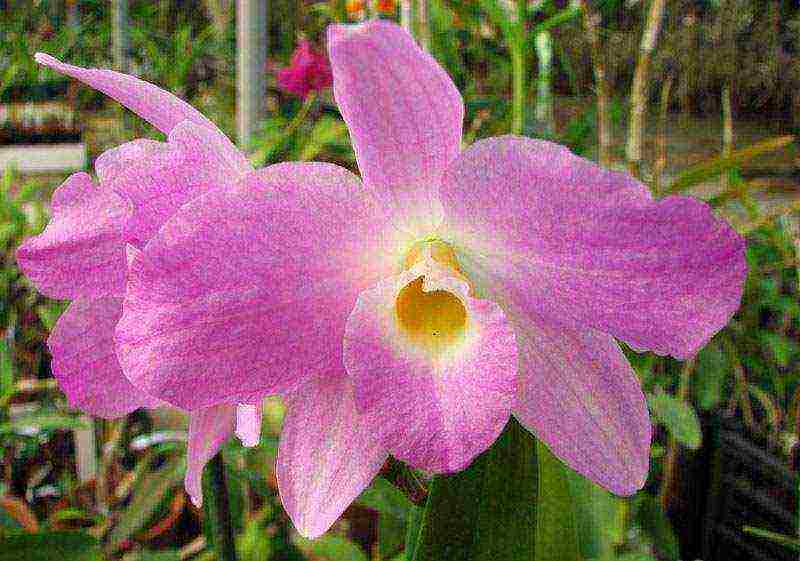
The name of this orchid speaks for itself, dendron - in Greek means "tree", bios - in Greek means "life". Dendrobiums, these typical representatives of epiphytes, there are about a hundred varieties and hybrids. In nature, the most widespread of them are Dendrobium Bouquet, Dendrobium Noble, Dendrobium Phalaenopsis.
Dendrobium at home
In room culture, Lindley's Dendrobium and Parisha Dendrobium took root most. These orchids produce white, lavender or a combination of the two with a flowering period of about 3 weeks.
The temperature of the dendrobium content is + 15- + 28 degrees, watering is plentiful, despite the fact that the plant is quite drought-resistant. In order to form healthy flowers, it needs mandatory feeding for the entire growth period and in bright lighting. Every two to three years, the substrate in which the dendrobium grows should be changed. Normally tolerates humidity of 55-60%, subject to periodic spraying.
Advice
For the summer, it will be nice if you move the orchid flowerpot to the balcony or garden, but only if you provide the plant with protection from rain, wind and direct sunlight.
5. Lelia
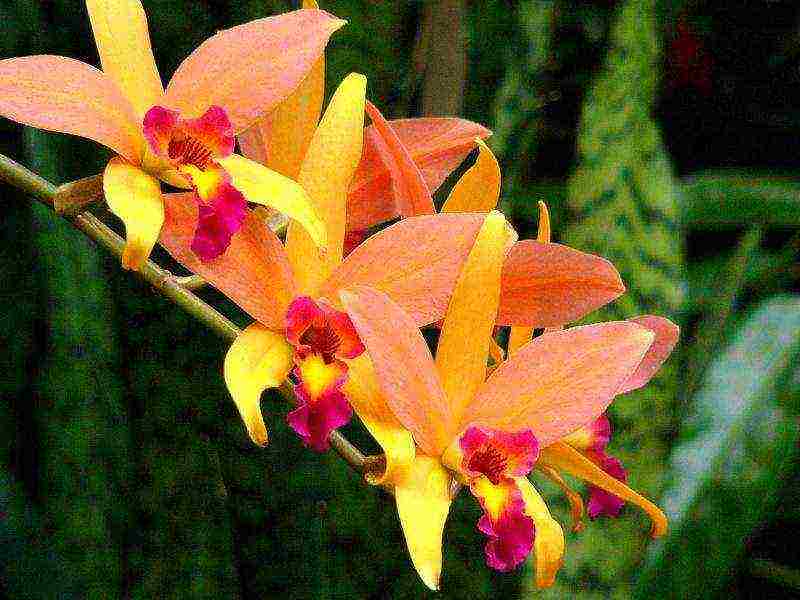
This genus of sympodial orchids has been known to breeders since 1831 thanks to John Lindley. By its appearance Lelia are similar to Cattleya. The culture thrives on home breeding.
Features of care for Lelia
Laelias require a cool, bright, damp environment. To ensure the required moisture level during the growth period, this crop should be frequently sprayed with a spray bottle. During flowering and dormancy, spraying is stopped.
In summer, Lilies should be protected from the bright rays of the sun by shading. During the same period, plants need abundant watering. But from the end of summer and throughout autumn, this culture needs to be provided with bright lighting and fresh air. At this time, new shoots are ripening. In winter, Lilleim is less irrigated.
6. Miltonia (Miltoniopsis)

German growers call it the "pansy" orchid because of its similarity to this flower. Natural habitat Miltonia - American tropics. Moreover, in Colombia there are cold-loving miltonia species growing on rocky mountain slopes, and thermophilic species found in the Brazilian jungle.
Features of Miltonia's content
For this type of orchid, the term "thermophilic" is relative. Because even the Brazilian miltonia prefers a year-round average temperature of + 21- + 23 degrees during the day and + 13- + 15 degrees at night. Moisture mode and watering - increased.
In summer and spring, protection from direct sun is required. It will be nice if you remove Miltonia from the windowsill into the interior for the summer. But at any time, this orchid needs a gentle stream of fresh air. At the end of flowering, the temperature of the plant should be lowered to +14 degrees.
The root system of this type of orchid is thinner and less fleshy compared to other types, so make sure that its soil is evenly moistened at all times. The watering regime in summer is intensive, in winter it is moderate. Given the delicate weak structure of the Miltoniopsis root system, do not allow waterlogging or drying out of the nutrient substrate. Otherwise, you risk losing the plant.
7. Paphiopedilum
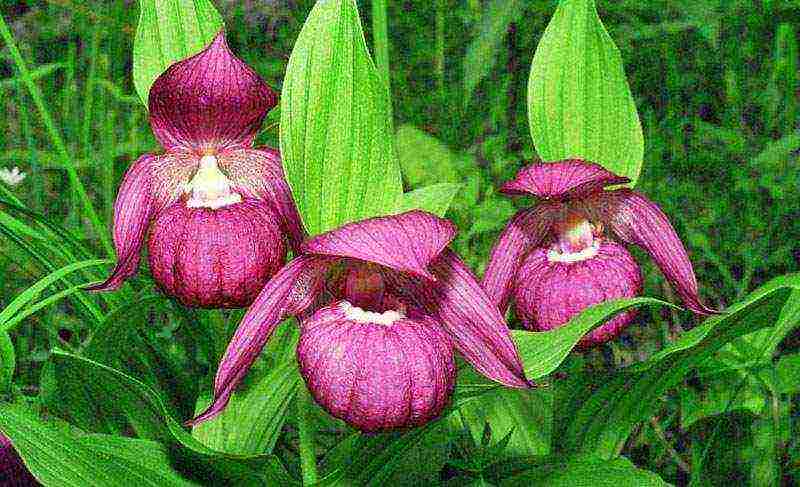
This orchid, with such a difficult to pronounce name, is the famous “lady's slipper". The shape of a woman's shoe is given to this flower by the saccular lip, characteristic of this type of flower. This orchid comes from the subtropical regions of Asia. It is a terrestrial orchid species.
Features of growing Pafiopedilum
Not all varieties of this species act as a room culture, but only those that are adapted to being kept in warm rooms during winter.As a rule, these are hybrids of papiopedilum (papiopedilum Nice, pafiopedilum Wonderful, papiopedilum Sukhakula, papiopedilum Spicer, papiopedilum Callous).
Depending on the type of "lady's shoes" can bloom either in winter or in summer, and flowering can last from several weeks to 2.5 months. In addition to the attractive original flower, these plants have spectacular motley leaves.
The temperature regime of the culture is + 18- + 25 degrees, watering is plentiful. Make sure that the substrate in which the orchid grows does not dry out. The feeding mode is moderate, the replacement of the substrate and the pot is after a year or two, the lighting mode is shaded, the ambient humidity is 50-70%.
Advice
This plant can safely spend summer in the fresh air, on a balcony or in a summer cottage, of course, in a place protected from rain, direct light and wind.
8. Wanda

Another famous species of orchids... The name "Wanda" in translation from Sanskrit means orchid variety. This plant is distinguished by two types of leaf shapes - flat and cylindrical. Long peduncles produce many large flowers that grow from the axils of the leaves. This species can produce flowers of a color uncharacteristic for orchids - blue. Almost all varieties Wandas have a pleasant aroma. The orchid blooms from late autumn - early winter.
Wanda in room culture
For this species, breeders have bred many hybrids, but keeping them in an apartment is not so easy, but possible.
First of all, Wanda needs a lot of light and high humidity. In winter, the temperature should not be allowed to drop to +13 degrees. And for the summer, this orchid can be moved to the fresh air of a loggia or a summer cottage - it can calmly withstand even the streams of direct rays of the sun.
9. Bletilla
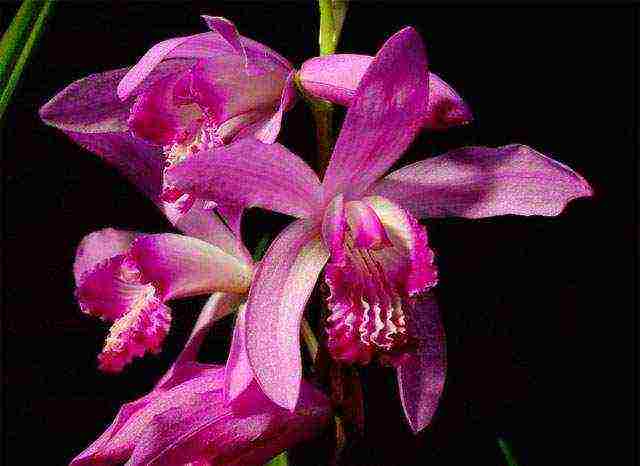
Bletilla, a beautifully flowering, herbaceous orchid growing from the ground, came to us from East Asia. There, some of its varieties are used in landscape design as an ornamental plant.
Features of the content of Bletilla
For breeding at home, a hybrid of Bletilla - Bletilla hyacinthina (Bletilla hyacinthina) is usually used.
The dormant period of this orchid begins in the fall, after the leaves die off. Therefore, it should be kept at low temperatures - + 5- + 13 degrees. At the same time, watering is not performed. If you cannot provide the plant with a period of cold dormancy, then do not expect flowers from it.
But if everything turned out fine with the rest mode, then in the spring Bletilla will certainly delight you with beautiful flowers. In the summer, a flowerpot with an orchid can be taken out to the loggia or in the garden, while you do not need to worry about darkening it - it calmly tolerates the bright sun. Just do not forget to abundantly and regularly water this beauty with large flowers.
10. Vuilstekeara
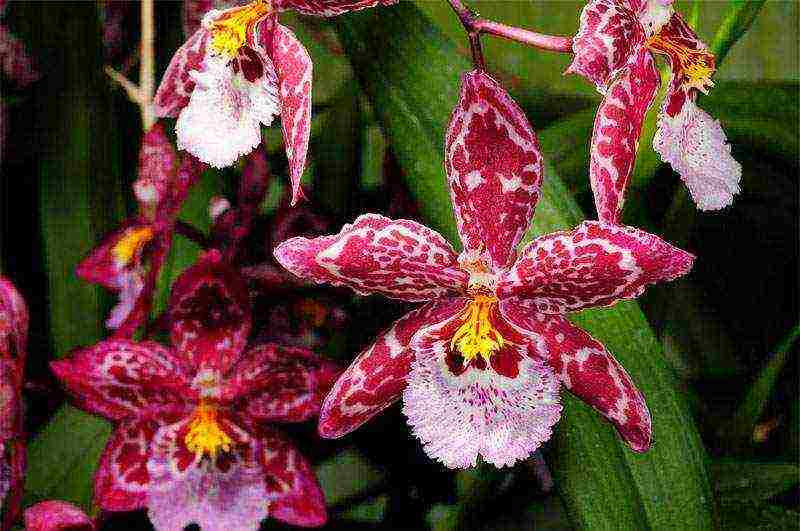
This unusually spectacular orchid was born in 1914 as a result of the hard work of Flemish breeders - crossing Miltonia, Cochlioda and Odontoglossum. That is why the lip of the orchid has a beautiful painting and the flower resembles a bright star.
This hybrid was originally bred for breeding in almost unheated rooms. A century ago, a more expensive flower could not be found. The most popular orchids are V. Edna, V. Cambria, V. Monica V. Plush, V. Linda Isler.
Caring for Wuilstekara at home
This orchid has special requirements for fresh air and good hydration. Subsequent watering should be carried out only after the substrate is completely dry. In winter, the intensity of watering should be significantly reduced. But the plant is not left without moisture, daily spraying the substrate from a spray bottle, trying not to touch the flowers. Temperature mode:
- for winter at night - + 13- + 18 degrees, in the daytime - + 18- + 20 degrees, a short-term decrease in night temperature up to +5 degrees is allowed,
- in summer, the orchid feels great in the fresh air of the balcony or under the dense crown of a tree in the summer cottage or in the garden.
If you do not have the opportunity to put the orchid outside, then put the Wuilstekeara flowerpot on the east windowsill.
This orchid is capable of blooming for 2 months, and the peduncle of an adult plant branches. You can achieve re-flowering if you provide coolness for two weeks in the fall at a temperature of + 12- + 13 degrees at night.
11. Phalaenopsis Orchid

These common orchids hold a leading position in their elegance, have long peduncles and bloom for more than one month. In addition, this is one of the budget orchid varieties, therefore it is available to any grower.
Features of growing Phalaenopsis
Phalaenopsis is quite adapted to growing at home at temperatures from +18 to +30 degrees. The orchid requires moderate watering. But the soil should be watered only after it is completely dry.
The feeding regime is also moderate, once every decade. Replacing the substrate and pot - every two years. Lighting mode - darkened southern or southeast windowsill in summer and light southern windowsill in winter. Calmly tolerates the low humidity of the apartment from 40 to 70%.
Interesting types of orchids
1. Orchid Dracula monkey (Dracula simia)
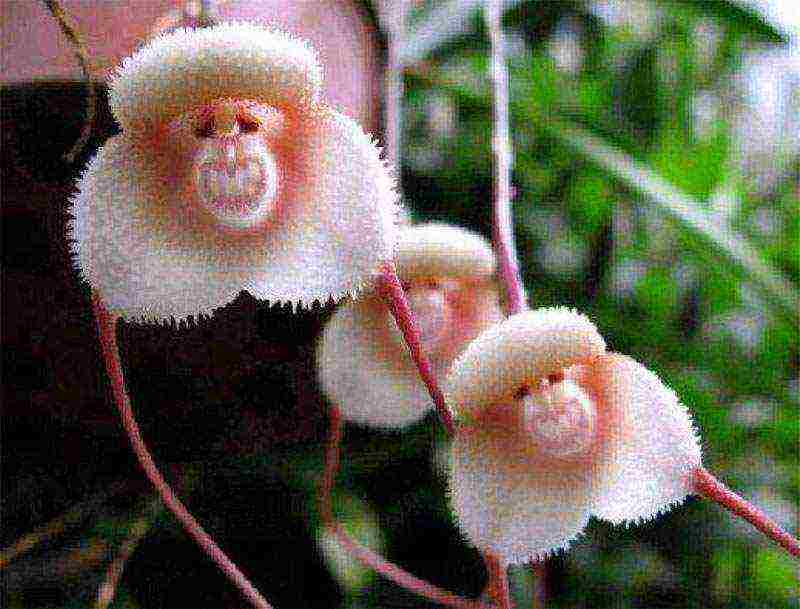
The Almighty was in a great mood when he created this miracle of nature and painted a funny face of a monkey on the petals of Dracula simia. This plant is forced to portray someone all the time in order to survive in nature and continue its kind.
2. Vanilla
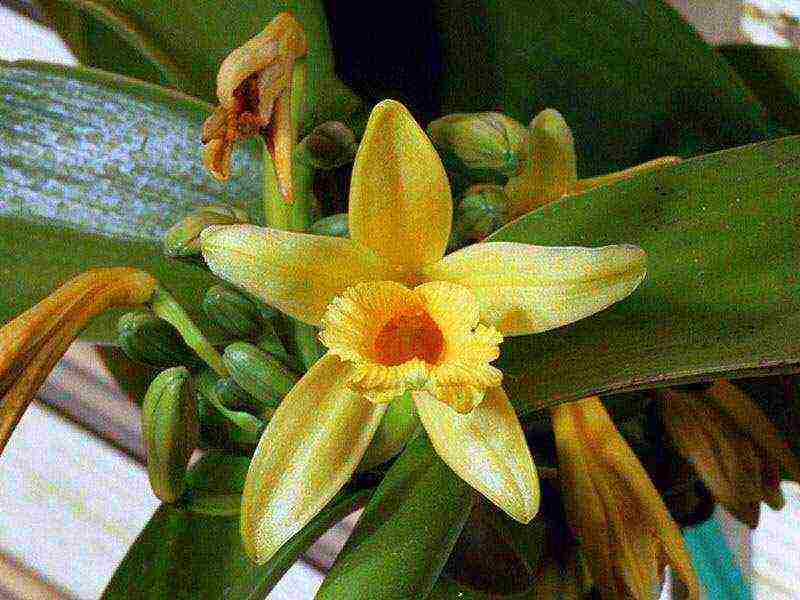
Yes, this is the same vanilla, dried by a special method, the ovary of which we are used to using as a butter spice, belongs to the genus of fragrant orchids. Vanilla is the only representative of this genus that humans use for food.
3. Orchid Lyubka
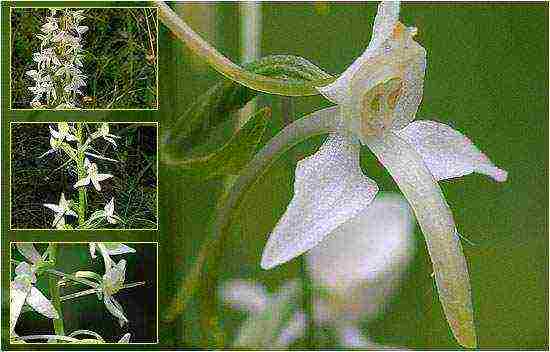
This is another original type of fragrant orchid, its flowers resemble not only a violet in their appearance, but are also capable of emitting an incredibly pleasant smell at night and cloudy weather.
4. Ophris fly

We have this orchid protected by law, because it is extremely rare. The natural habitat of this orchid, unusual in shape and color, is the carbonate soils of low-lying bogs, lime pits and swampy meadows in Asia Minor and Europe.
4. Makodes petola
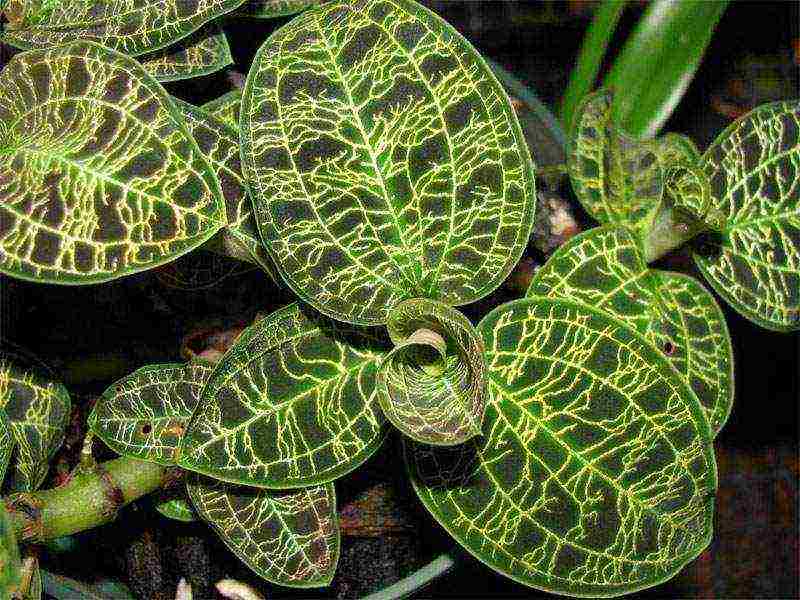
These orchids are distinguished by extremely beautiful foliage, but their flowers are small and expressionless. Therefore, they grow Makodes petolu solely for the sake of her precious leaves, covered with silvery or golden streaks and veins. This group includes a number of genera such as Macodes, Ludisia, Anectohilus, Gudiera, originating from the tropics. Growth area - forest floor, tree trunks.
These terrestrial plants do not have a dormant period. Orchids give creeping, strong, fleshy shoots at the top of which from a loose rosette sprout short-peaked velvety rounded emerald leaves. The leaves of Makodes petola are covered with veins shining in the sun. Against their background, reddish-brown white-lipped flowers look like poor relatives. The flowering period is autumn - winter, but is it of interest to us in this case?
5. Oncidium
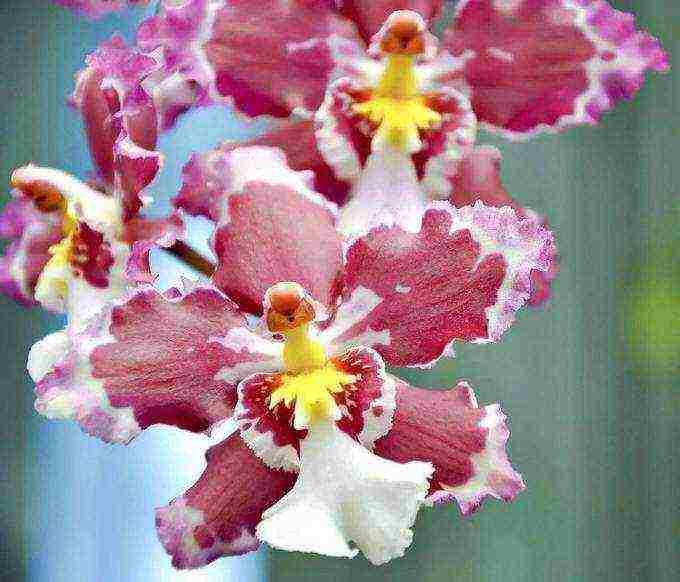
This charming orchid is a butterfly with golden flowers and an intricate shape. There are 100 known species of this inhabitant of the American tropics. They mostly prefer mountainous areas.
The Brazilians called these orchids a butterfly - it is in their country that specimens resembling this insect are found. And among American plant breeders it is customary to call this beautiful orchid "dancing doll". Pragmatic Germans call it a calloused orchid because there are warty growths on its lip.
The flowering period of this species is autumn - winter. Bird-billed Oncidium grows flowers in the shape of a bird's beak, smelling of vanilla.And the most unpretentious in breeding are Oncidium Kudoyavy, Oncidium Forbeza, Oncidium Wide.
In the video you will see for yourself how beautiful orchids are.
Orchid Buying Tips
And finally, we want to bring a few tips on what to look out for when purchasing an orchid in a shop, garden center or nursery:
- the most suitable place for replenishing the collection of orchids is the nursery,
- when buying, be sure to ask about the orchid variety, the preferred conditions for its maintenance, and not just ask, but write it down on paper or ask for a printout with a description,
- buy only blooming orchids, otherwise you not only run the risk of buying a pig in a poke, having no idea of either the color or the shape of the flowers, but also buy a sick plant,
- do not get fooled by discounts, free cheese - in a mousetrap, orchid flowers should be bright, fresh, strong and elastic, there should be no torn or dried flowers on the peduncles,
- carefully examine the leaves, they should have a uniform emerald green or reddish green color, they should not have dark blotches or yellowed areas. The foliage should not be lethargic or dry.
- the roots should be firm and fleshy, it would be nice if some of them crawled out of the substrate, this is a sign of good plant health,
- Once you are satisfied that you have chosen a viable plant, ask the seller to package the orchid so as not to expose it to large atmospheric changes and damage during transport.
Happy shopping!
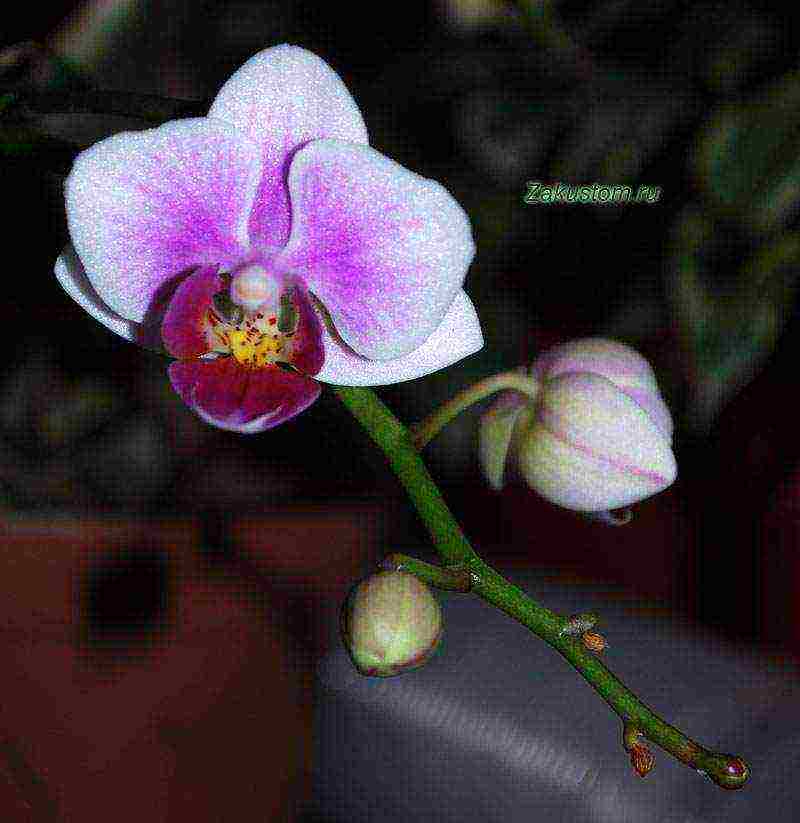
Read related articles
